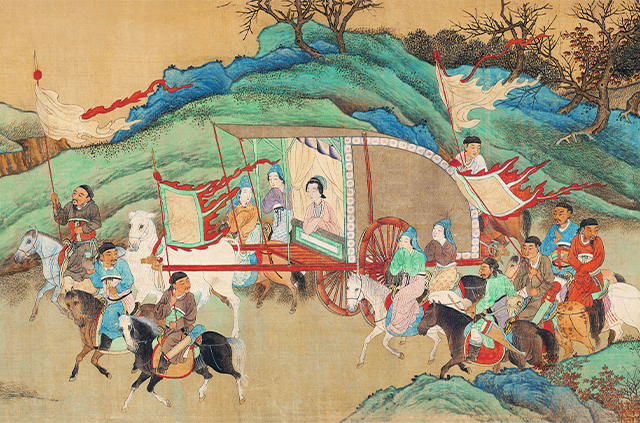Qiu Ying
Series: The Royal Collection of Imperial China
Artist: Qiu Ying
Period: Ming Dynasty (1368–1644)
Medium: Handscroll
Dimensions: 472 × 22 cm
Price: $459.95
ISBN: 978-1-4878-0148-9
(Collected by the National Palace Museum, Taipei)
DESCRIPTION
Ink and color on silk; length 28 cm, width 467.5 cm
This painting depicts the story of Wenji, a talented lady of the late Eastern Han Dynasty. The story has been told in novels, poems, and plays, and also adapted to musical scores for various instruments. The story and its adaptations are widespread. Several paintings depicting the scene of Wenji returning to Han are inscribed with the name Qiu Shifu, but the one presented here is the liveliest and most colorful.
In this scroll, the honor guard, carriage, and horses are vividly portrayed without the aid of rulers. Even without drawing aids, Qiu was able to draw straight, powerful lines. For years, his skill was unequalled.
The buildings and pavilions in the landscape are vividly rendered in a vigorous, powerful style, as if they stand immediately before the viewer. The painting is so lifelike it is as if the painter is inviting the viewer to relive the story told on the scroll. Many have commented that Qiu Ying is rightfully called “the master painter of his time, with consummate skills.”
[ABOUT THE PAINTER
Qiu Ying (c. 1501–1551), also known by the aliases Shifu and Shizhou, excelled in the portrayal of figures, initiating the “Qiu Style” of figure paintings of ladies. He was also skilled in coloring, and excelled both in ink and wash and line drawing techniques for fine figure painting. Qiu Ying was able to use different skills to present different subjects, including smooth, gentle, elegant brushstrokes, or others that were vigorous, powerful, and dashing. Occasionally, Qiu turned his hand to bird and flower paintings, which are bright and well-designed. In painting mountain landscapes, Qiu further promoted the style of “hiding traces of people in the mountains,” bringing the technique to its peak. Because of his pluralistic style, Qiu was praised as an “all-round” master painter. He is known as one of the Four Great Master Painters of the Ming Dynasty, alongside Shen Zhou, Wen Zhengming, and Tang Yin.

